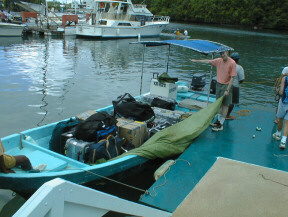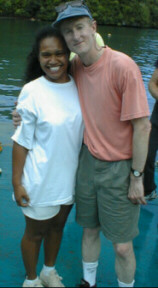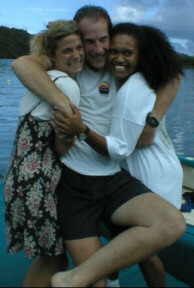Daily Log Report for
16
May 1997
Submitted by Richard Pyle
 Today the
film crew packed up and left us to return to the U.S.
While they were packing their 25 pieces of luggage, John,
Pat and I went out for a mid-day dive. Yesterday's break
from deep diving allowed us to consider in detail the
bailout situation of the previous day's dive. My problem
(flooded breathing loop) was pretty easy to analyze: a
clear case of diver error -- I had neglected to replace
the drain plug. I could easily try to blame it on
fatigue, lack of sleep, the demanding schedule we were
trying to follow; but the bottom line is that I had
become complacent and bypassed the pre-dive checklist on
the rebreather's computer system (which includes a
reminder to replace the drain plug), so it was entirely
my fault. The upside of this careless mistake is how
incredibly easy the bailout procedure was; given that I
was highly task-loaded and it occurred toward the end of
the dive and thus I owed a lot of decompression time. The
gas supplies that are built in to the rebreather (80
cubic feet of diluent, of which 60 cubic feet is safe to
breathe at maximum operating depth) were more than
adequate for me to return to the bailout gas supply. I
could have easily left the bailout supply and immediately
began my ascent; but there was no need for that. Because
we treat all dives as solo dives (regardless of how close
we stay together on the bottom), the fact that John was
not nearby was inconsequential. (Though unconventional by
most diving standards, we feel this approach to deep
diving on coral reefs while collecting specimens is by
far the safest route to follow. Through experience in
doing these sorts of dives, we have discovered that the
conventional "buddy system" may lead to more
potential problems than it solves.) The situation was so
relaxed, in fact, that I took the time to photograph John
collecting fish on the way up. Moreover, as soon as I
figured out the problem, I was able to fully recover the
rebreather, and continue for 2 more hours without any
problem at all. When I opened the canister after the
dive, I found that the Lithium Hydroxide was completely
dry, and therefore I used it again today -- with
absolutely no problem at all. This sort of positive
reinforcement regarding bailout schemes during real-world
bailout scenarios is very encouraging.
Today the
film crew packed up and left us to return to the U.S.
While they were packing their 25 pieces of luggage, John,
Pat and I went out for a mid-day dive. Yesterday's break
from deep diving allowed us to consider in detail the
bailout situation of the previous day's dive. My problem
(flooded breathing loop) was pretty easy to analyze: a
clear case of diver error -- I had neglected to replace
the drain plug. I could easily try to blame it on
fatigue, lack of sleep, the demanding schedule we were
trying to follow; but the bottom line is that I had
become complacent and bypassed the pre-dive checklist on
the rebreather's computer system (which includes a
reminder to replace the drain plug), so it was entirely
my fault. The upside of this careless mistake is how
incredibly easy the bailout procedure was; given that I
was highly task-loaded and it occurred toward the end of
the dive and thus I owed a lot of decompression time. The
gas supplies that are built in to the rebreather (80
cubic feet of diluent, of which 60 cubic feet is safe to
breathe at maximum operating depth) were more than
adequate for me to return to the bailout gas supply. I
could have easily left the bailout supply and immediately
began my ascent; but there was no need for that. Because
we treat all dives as solo dives (regardless of how close
we stay together on the bottom), the fact that John was
not nearby was inconsequential. (Though unconventional by
most diving standards, we feel this approach to deep
diving on coral reefs while collecting specimens is by
far the safest route to follow. Through experience in
doing these sorts of dives, we have discovered that the
conventional "buddy system" may lead to more
potential problems than it solves.) The situation was so
relaxed, in fact, that I took the time to photograph John
collecting fish on the way up. Moreover, as soon as I
figured out the problem, I was able to fully recover the
rebreather, and continue for 2 more hours without any
problem at all. When I opened the canister after the
dive, I found that the Lithium Hydroxide was completely
dry, and therefore I used it again today -- with
absolutely no problem at all. This sort of positive
reinforcement regarding bailout schemes during real-world
bailout scenarios is very encouraging.
John's problem -- that of too much narcosis at depth -- is somewhat more perplexing. We discovered that the pressure gauge on the transfill hose we had been using to blend our gas mixtures was faulty, so at first we believed that to be the source of the problem. However, upon analyzing the trimix supply for oxygen content, we discovered that the mixture was indeed correct. We intended to blend a mixture of 66% helium, 10% oxygen, and 24% nitrogen. The measured oxygen content of John's trimix was 11%. Even if we had filled the cylinder with just helium and air, the most nitrogen we could have possibly had in the trimix would be about 41%. At an ambient pressure of 10 ATM, the highest possible nitrogen partial pressure would have been 4.1 ATM; roughly the equivalent of air at a depth of 140 feet. While this depth may induce narcosis in some individuals, for someone with as much deep diving experience as John, this level of narcosis would have been trivial. But the fact is, we had put some pure oxygen in the trimix during blending, which means the nitrogen fraction was even less than 41%, and probably was, in fact, only 24% (equivalent to narcosis experienced at less than 70 feet on air). We are still left wondering why John experienced such high levels of narcosis during his deep descent. There are several possible explanations, but none of them make much sense. Because it neither presented a problem, nor exacerbated any other problem during the dive, we decided to cautiously proceed with today's dive.
Today's dive went very well. This time, John planned to stop his descent at 220 feet in order to collect more specimens of the wrasse we have referred to as Cirrhilabrus sp. 1 (which we now believe may be Cirrhilabrus rubromarginatus). Pat (using his home-built closed circuit rebreather, which he has described in a brief article on this web page) joined me to the terrace at 300 feet, and swam around towards a cave where I had seen some unusual invertebrates. My mission was to fill another mesh bag with rocks and send them to the surface, then try to collect more species. Pat's plan was to limit his time at depth to 10 minutes, and my plan was to stay only 15 or 20 minutes, to keep the decompression time relatively short.
Before presenting today's dive log, I wanted to include a few photographs of the film crew saying "goodbye" to Carla Salii. Carla works here at CRRF, and has been an incredible help and source of encouragement. It has been extremely delightful working with her!



